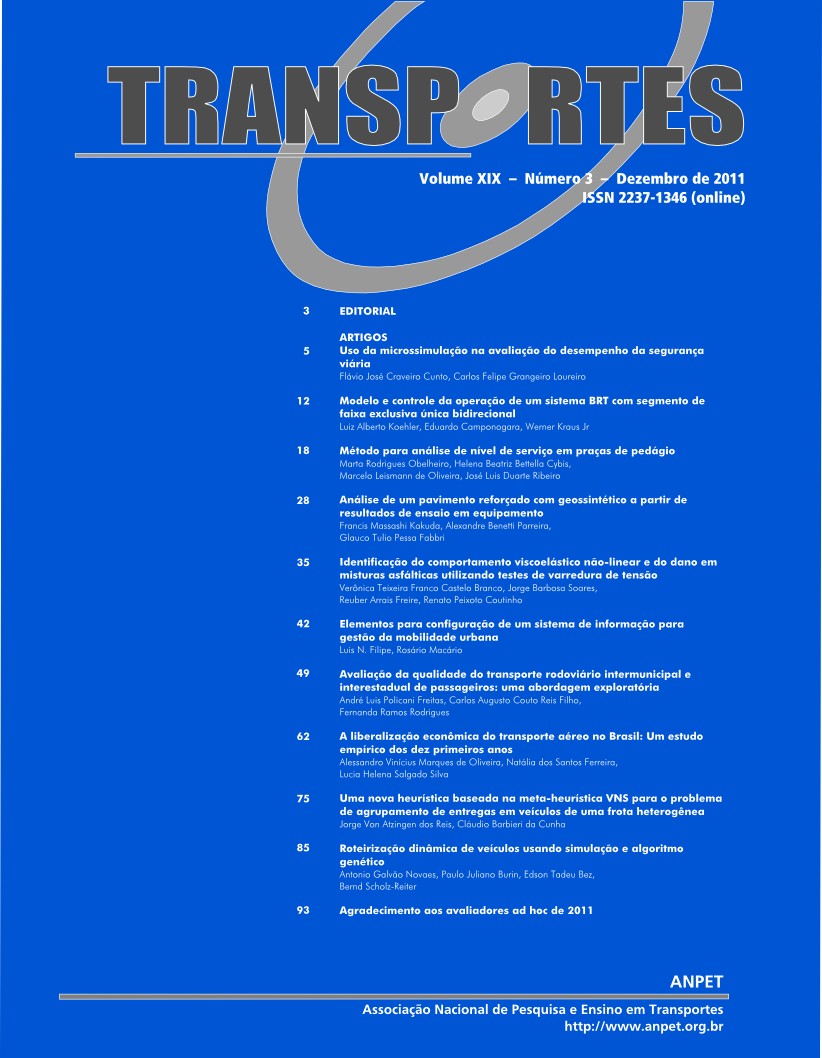O uso da microssimulação na avaliação do desempenho da segurança viária
DOI:
https://doi.org/10.14295/transportes.v19i3.527Abstract
Resumo: Este artigo apresenta uma discussão sistematizada sobre os diversos aspectos que caracterizam o potencial do uso da mi-crossimulação em estudos de segurança de tráfego. Inicialmente, faz-se uma revisão dos principais indicadores de desempenho da segu-rança viária, analisando sua evolução conceitual e a pertinência na utilização de modelos de microssimulação na sua estimativa. Em se-guida, são descritas as principais características dos simuladores a serem observadas quando utilizados em estudos de segurança. São discutidos também aspectos referentes ao processo de calibração e validação dos algoritmos de modelagem microscópica para esse tipo de aplicação, além da necessidade de validar a relação entre indicador simulado e situações de risco de acidentes observadas em campo. Ao final, conclui-se que são inúmeras as oportunidades e os desafios de pesquisa nessa área, incluindo novas formas de representação dos conflitos/interações no tráfego, as simplificações inerentes aos algoritmos de modelagem microscópica, os procedimentos de calibração e validação desses algoritmos, assim como a validade relativa dos indicadores de desempenho para refletirem o contexto real da segurança viária.Palavras-chave: simulação microscópica, segurança viária, indicadores proxy de segurança viária.
Abstract: This paper presents a systemized discussion on the different aspects that characterize the potential use of microscopic simu-lation in traffic safety studies. Initially, it is presented a literature review on the existing traffic safety performance measures, analyzing their conceptual evolution and the appropriateness of using microscopic simulation models in their estimation. Following, there is a description of the main characteristics of traffic simulators to be observed when applied to safety studies. There is also a discussion on the aspects related to calibrating and validating microscopic modeling algorithms for this type of application, as well as the need to validate the relationship between simulated measures and imminent accident situations observed on the field. At last, it is concluded that there are many research opportunities and challenges in this area, including new means of representing traffic conflicts/interactions, simplifications inherent to microscopic modeling algorithms, procedures for calibrating and validating these algorithms, as well as the relative validity of the performance measures to reflect the real context of road safety.
Keywords: microscopic simulation, road safety, surrogate safety measures.
Downloads
Download data is not yet available.
Downloads
Published
2011-12-30
How to Cite
Cunto, F. J. C., & Grangeiro Loureiro, C. F. (2011). O uso da microssimulação na avaliação do desempenho da segurança viária. Transportes, 19(3), 5–11. https://doi.org/10.14295/transportes.v19i3.527
Issue
Section
Articles
License
Authors who submit papers for publication by TRANSPORTES agree to the following terms:
- The authors retain the copyright and grant Transportes the right of first publication of the manuscript, without any financial charge, and waive any other remuneration for its publication by ANPET.
- Upon publication by Transportes, the manuscript is automatically licensed under the Creative Commons License CC BY 4.0 license. This license permits the work to be shared with proper attribution to the authors and its original publication in this journal, and to be adapted for non-commercial purposes, provided appropriate credit is given and any derivative works are distributed under the same terms.
- Authors are authorized to enter into additional separate contracts for the non-exclusive distribution of the version of the manuscript published in this journal (e.g., publishing in an institutional repository or as a book chapter), with recognition of the initial publication in this journal, provided that such a contract does not imply an endorsement of the content of the manuscript or the new medium by ANPET.
- Authors are permitted and encouraged to publish and distribute their work online (e.g., in institutional repositories or on their personal websites) after the editorial process is complete. As Transportes provides open access to all published issues, authors are encouraged to use links to the DOI of their article in these cases.
- Authors guarantee that they have obtained the necessary authorization from their employers for the transfer of rights under this agreement, if these employers hold any copyright over the manuscript. Additionally, authors assume all responsibility for any copyright infringements by these employers, releasing ANPET and Transportes from any responsibility in this regard.
- Authors assume full responsibility for the content of the manuscript, including the necessary and appropriate authorizations for the disclosure of collected data and obtained results, releasing ANPET and Transportes from any responsibility in this regard.









